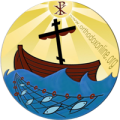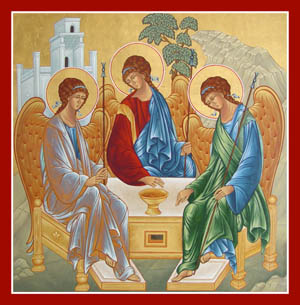In the Orthodox icon there are multiple symbols. We will try to understand the most important icon symbols found in our church, especially the ones most used in the liturgy. It is worth noting that the symbols affect the colors, the geometry of the icon’s lines, the distribution of scenes, as well as the position of the body. The icon starts from the reality of the event in history and place, to transport us to a deified, manifested reality.
Colors :
- Dark red: symbolizes suffering humanity, the love of Christ, and divinity.
- Blue: a symbol of knowledge that is not perceived by the mind but by the heart. It symbolizes divine glory.
- Green: symbolizes renewal and human nature.
- Golden: symbolizes eternity, the eternal and imperishable kingdom (all icons are based on the golden color).
- Yellow: symbolizes divine light.
- White: symbolizes purity and the glow of divine light.
- Black: symbolizes loss, the unknown, and the darkness of sin and death.
- Brown: symbolizes the earth, as the first Adam was made of dust.
- Violet: Symbolizes union with God (a combination of blue, human nature, and red, symbol of divine nature).
Icon of Abraham's hospitality
- The angel representing the Father points to the cup in the center, which contains the Paschal Lamb. The Father looks to the Son.
- The angel to the left of the Son represents the Holy Spirit. Darker blue than the Son because he sends the knowledge of the Trinity into the earth.
- The Father's view of the Son: divine love and eternal outpouring.
- The scepter and wand are a symbol of care and education.
- The icon focuses on the cup in the middle: the Paschal Lamb.
- The mountain represents the entire universe.
- The building symbolizes the church, that is, the new world in Christ Jesus.
- The bending position of the angels' bodies creates the shape of a cup.
- The central curvature of the angel's face is the same as the curvature of Christ's head on the cross, symbolized by the tree (tree of life) behind the angel.
Palm Sunday icon
- The tree: symbolizes the tree of life in Paradise and the cross, as in the icon of Abraham’s hospitality.
- The Master sitting on the colt demonstrates the Lord’s humility, and the animal also symbolizes the bestiality of the nations that the Master exalted and made exalted.
- There is a contrast between the joyful children in the Tree of Life and the people singing “Hosanna,” as well as the clear complaining of the Jews at the gates of the city.
- The eyes of children responding to the presence of the Lord call to emulate their innocent purity.
Icon of the Master's entry into the temple
- Dark red: suffering humanity.
- Red Curtain: Divine knowledge connected the two temples by the red curtain (a symbol of redemption).
- God's love bound the legal structure and transformed it into a new structure, the Church. This love is divine knowledge, and the curtain is the act of redemption
The icon of Our Lady entering the temple was not mentioned in the Bible, but in tradition and liturgy.
- Focus on Zechariah: The law awaits this event.
- Joachim and Anna: a symbol of waiting and the fulfillment of Old Testament prophecies.
aAppearance icon:
- John touches the Lord's head with trembling.
- The son is naked (paradise life), pointing with his hand to the waters to sanctify them, and hence the service of sanctifying the waters, as if he was calling on Adam to wash with him and be cleansed of sins.
- The water appears like a cave (anticipating burial). This idea will become clearer in the icon of the descent into hell.
- Christ's stomach is a dilemma that refers to the pain and anticipation of the cross.
- The length of the bodies symbolizes the virgin soul, the human being in glory.
- Angels
Humanity moving toward the Son. Redeemed humanity glorifies God the incarnate Son in its service to the Son. Humanity believed in the coming of Christ and was enlightened by his light. - the fish
Remember the Lord Jesus Christ, the Son of God, the Savior. - Dove
In their interpretation of baptism, the Fathers go back to the story of Noah and the dove that brought an olive branch, and to the fact that the spirit, since creation, has been fluttering on the surface of the waters.
Transfiguration icon:
- In the Transfiguration, the glory of Christ was revealed to the disciples for the first time.
- Christ is clothed with light like a garment.
- Moses represents the law of the Old Testament, and Elijah the prophets of the Old Testament, and symbolizes our resurrection and ascension with the Lord because he ascended in the chariot of fire. They talk to Jesus and bear witness to him.
- John: incomprehensible, rolled away, wearing a red dress, a symbol of love.
- Peter: The Lord speaks.
- Jacob: He covers his head without understanding.
- The mountain represents the entire inhabited earth.
- Disciples: The humanity that before the cross, the grave, and the resurrection did not understand anything.
- The halo of Christ: symbolizes divine glory.
- Blue color: not close to it.
- Arrows: Ray of Divine Light.
- John: He has his eyes closed and does not understand, but he accepts everything.
- Peter: 3 tents (the tent of testimony).
- Those who carry a scroll (book) in the icon are the prophets and evangelists.
Icon of the revival of Lazarus:![]()
- The Jews surrounding him: do not understand.
- The disciples after Christ began to understand the cross.
- Lazarus in the darkness of the tomb, next to him are Mary and Martha.
- The tomb has the same shape as the apparition icon.
- Dark blue: a symbol of the secret that is unapproachable and unknowable by the mind.
- Rocks and mountains are a symbol of the universe.
Icon of the Last Supper:
- Round shape of the table: the unity of sacrificial action, the act of redemption and the incarnation.
- The contrast between John leaning on Christ's chest and Judas. For parents, the heart is the source of knowledge. He leaned on his chest because he understood what was going on, while Judas did not understand, according to the liturgical texts, but rather his concern was to take.
Cross icon:
- The divine ladder by which we ascend to heaven has its roots in the depths of hell and leads to heaven.
- The Virgin: dressed in dark red, the same color as the Christmas icon, wrapped in humanity protected by the love of the Lord.
- John the Beloved: He wears red as a symbol of his love for Christ.
- Height: a symbol of the virginal soul, because it is human in glory and not natural.
- Hell: represented by a skull.
Icon of the Resurrection:
- He should not be drawn wearing white clothes as in the Transfiguration, but rather he should be drawn wearing brown clothes because it indicates that Christ Jesus is the one who died on the cross.
- Christ, clothed in light (the transfiguration), catches Adam (or the dustman) and pulls him out of hell. Dismantled keys and locks of Hell appear as well as doors.
- Eve: Devoted humanity to her Lord.
- Satan: A dark-colored being, chained and defeated.
Ascension icon:
- According to tradition, the Virgin is present representing praying humanity.
- Angels talking to the disciples.
- The glory of Christ is in the clouds where the divine presence is.
Pentecost icon:
- The disciples are a semicircle (the work of redemption continues in them: they represent the world).
- The soul in the form of fire (purifies).
- The old man in the cave is a reference to the universe, and the cave is dark, inviting him to accept the baptism of fire.
- In the handkerchief are the good tidings of the twelve apostles (Rev. 20).
Icon of the Annunciation:
- The Virgin represents the praying Church that conceives the Incarnate Word and accepts the Lord’s plan with simplicity of heart.
- The guardian angel advances with graceful movement and respect.
Birth icon:
- The Virgin sits without pain and emotion, indicating the wondrous birth, wrapped in dark red (celibacy).
- Youssef looks confused and Satan is worrying him with thoughts.
- Christ's swaddling clothes are like the shrouds, the cave is like the grave, and the manger is like the grave.
- The donkey and cow represent the bestiality of the nations from which Christ came to save us.
- The shepherds are amazed. Angels praise, the star indicates the position of the Lord.
- The Magi represent three stages of human life: youth, youth and old age.
Icon of the Dormition of Our Lady:
- Christ carries the soul of the Virgin in glory in the form of a swaddled child, indicating her innocence.
- The apostles around the Virgin pay due honor to the Mother of God, who surpasses all human beings. From that moment on, she enjoys divine glory with her son.
- After the eleventh century, a man was added trying to make her fall, but an angel cut off his hand with a fiery sword.
Archimandrite Panteleimon Farah

